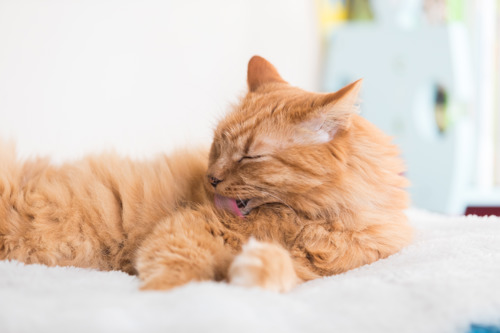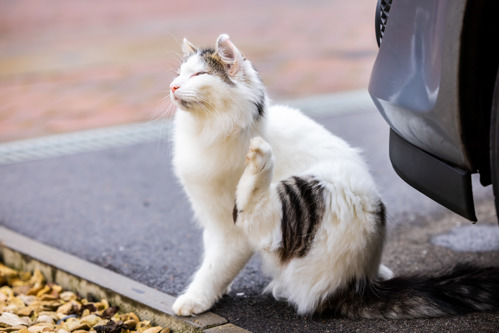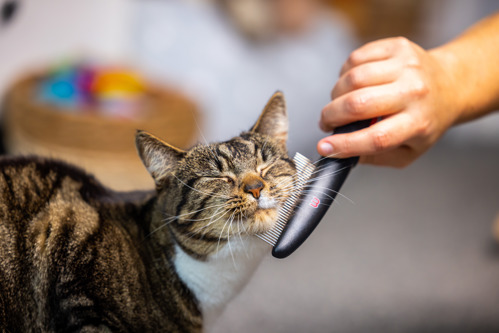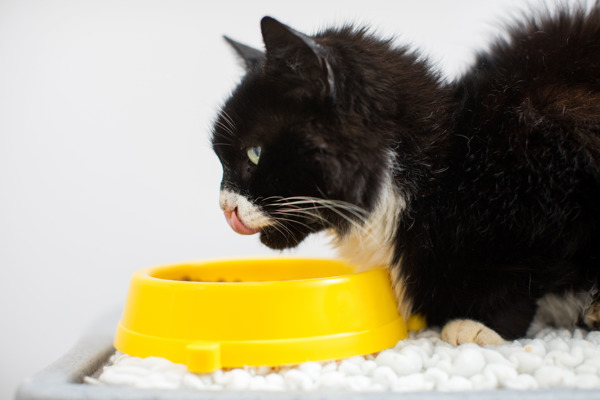Dandruff could be a sign that your cat is unwell. But there are treatments and remedies available from your vet to get rid of dandruff
There’s nothing better than stroking your furry friend’s soft, silky coat as they purr in delight. Normally their glossy fur will be in tip-top condition. But like humans, cats can experience problems with their skin and hair. One condition they may encounter is dandruff.
Dandruff is small, white flakes of skin that appear through your cat’s fur or on their skin. It can occur anywhere on the body but is more commonly found along the lower back or around the base of the tail. Cat dandruff is also sometimes called ‘scale’ or ‘scurf’ by vets.

A small amount of dandruff can be normal for cats. They are constantly shedding old skin cells to make way for healthy new ones. Cats will usually keep their skin and fur healthy by grooming themselves with their tongues. This removes dandruff in the process. But if you notice that your cat has a large amount of dandruff, there could be a problem.
While the dandruff itself isn’t painful for cats, the cause of the dandruff could be causing them discomfort. The dandruff is unlikely to go away until the cause has been treated and resolved.
Dandruff or dander?
It’s important to understand the difference between dandruff and dander.
Dander is the dead skins cells that cats shed all the time and is completely healthy and normal. You won’t be able to see dander as it is microscopic. Dander, as well as fur, is what spreads the protein that causes cat allergies. Cats transfer this protein from their saliva to their skin. Then it spreads around the home via dander and fur. Find out more about cat allergies.
Dandruff is larger flakes of skin that you will be able to see with the naked eye. All cats produce dander but not all cats produce dandruff.
Dandruff or fleas?
Dandruff can sometimes be confused with flea eggs or dirt. But often dandruff and fleas can happen at the same time. Flea dirt is the poo (faeces) of fleas and appears as small black or brown flecks on the cat’s skin or fur. Flea eggs are off-white and oval shaped, about the size of a grain of salt. They hatch into off-white larvae that look like tiny worms. Find out more about fleas.
Causes of dandruff in cats
Dandruff is usually caused by dry, flaky skin but it can be caused by oily/greasy skin too. This results in a build-up of skin cells that then flake off. If your cat is producing a lot of dandruff there could be many possible causes. Speak to your vet to find out the cause and discuss appropriate treatment.
1. Cat not grooming themselves properly, which can be caused by:
- arthritis
- pain or stiffness
- being overweight
- dental disease
Find out more about cat grooming.
2. Skin problems, such as:
- fleas
- skin allergies
- skin infections
- ringworm
- mites, lice, ticks and other parasites
- hormonal conditions such as hyperthyroidism or diabetes
- autoimmune skin disease (such as pemphigus) although this is very rare
- primary seborrhea, an inherited condition in Persian cats
- cancer, although dandruff is a rare symptom
Find out more about skin problems in cats.
3. Low humidity
4. Poor quality diet
5. Dehydration
6. Stress
What is cheyletiellosis, also known as ‘walking dandruff’?
Cheyletiellosis is a skin disease caused by mites called cheyletiella spp. These mites can be found on cats, dogs, rabbits and other animals. They can easily pass between animals if there is close contact. They can also pass to humans too. In severe infestations, the white mites can sometimes be seen walking across the skin. This is why this condition is sometimes know as ‘walking dandruff’. Animals with cheyletiellosis may show no symptoms. But the most common symptom is scaling of the skin, which results in dandruff. If you notice dandruff or mites on your cat’s skin, take them to your vet. They will be able to identify the cause and provide appropriate treatment.
Symptoms of cat dandruff

If your cat is showing any of the following symptoms alongside flaky skin, they could have a medical condition needing treatment. Speak to your vet straight away.
- Limping or stiffness
- Itching
- Grooming less or more than usual
- Rashes or red skin
- Hair loss
- Greasy fur
- Weight loss
Cat dandruff remedies
The best treatment for your cat’s dandruff will depend on the cause. Speak to your vet to find out what they recommend. If your cat has no health conditions causing the dandruff, your vet may recommend any of the following home remedies for getting rid of cat dandruff:
- food. There may be specific types of cat food that your vet can suggest to improve your cat’s skin and coat
- skin supplements, such as those containing fish oil, that are designed for cats and can improve dry skin
- topical treatment (applied onto the skin). Your vet may recommend this treatment depending on the cause of the dandruff and how severe it is. It should only be used as instructed by your vet
How to keep your cat’s fur healthy

To keep your cat’s fur soft and silky and help prevent dandruff, follow these top tips.
- Feed the right diet: Giving your cat a complete cat food suitable for their age should give them all the nutrients they need to keep their coat healthy. It should say ‘complete’ on the label. Also give them plenty of fresh water every day to prevent dehydration and dry skin. Find out more about feeding your cat.
- Help with grooming: Cats are usually very good at grooming themselves. But you can give them a helping hand using a brush or other grooming tool. Short-haired cats will only need brushing around once a week. Long-haired cats will appreciate a daily groom. Find out more about grooming your cat.
- Provide flea treatment: To prevent fleas from getting into your cat’s fur and spreading around your home, speak to your vet about which flea treatment you should use. They can also tell you how often you should use it based on your cat’s lifestyle. Find out more about fleas.
- Control the humidity: Dry air could cause your cat’s skin to dry out and become flaky. Try using a humidifier to add moisture to the air at home, especially during the dry winter months.



